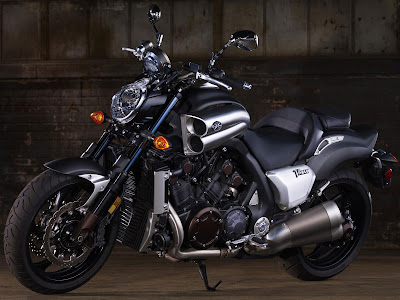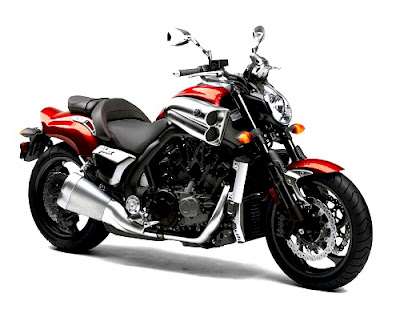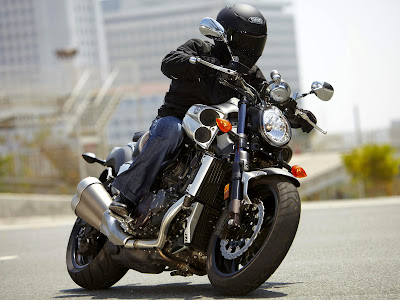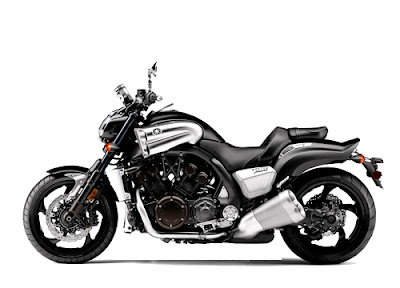The ultimate power cruiser delivers unparalleled performance and style.
Unlike other bike available today, the 2012 Yamaha VMAX is truly in a class by itself. The impressive acceleration and muscular beauty, combined with sporty handling and the latest technologies of Yamaha electronic engine management an incredibly exciting ride.
The legend continues.
In '85 the original V-Max turned the motorcycle world on its head. Our engineers have a large dose of the original "Mad Max" DNA then added a bunch of the latest technologies Yamaha sports bike and battery chips access variable, a high-tech fuel injection and our famous fly throttle. The result is the next generation of VMAX. The legendary sound, engine character and amazing acceleration are part of the latest designs, but there is a twist. The VMAX offers truly sporty handling, thanks to the lightweight aluminum chassis and fully adjustable suspension. Scorched a curb lately?
The maximum muscle bike.
The 2012 Yamaha VMX17 is the ultimate union of muscle and brains, and is the result of the fracture of the floor of their evolutionary journey. The unique features of the characteristic animals are richly combined with advanced technology and sport bike style visionary. It all ads to a machine with great performance and visual power. The 2012 Yamaha VMAX truly in a class by itself.
2012 Yamaha VMAX / VMX17 prominent and important features:
Fuel ± 11.4kpl, 32mpg (Imp)
1679cc, V-4 engine with the YCC-I and YCC-T
Aluminium frame with fully adjustable suspension
Key Features:
• The ultimate power cruiser delivers unmatched performance in the 65 degrees, lock-cylinder four-valve, 1679cc V4-plenty of eye opening, controllable acceleration from a compact engine that is as powerful as it is.
• four bore downdraft fuel injection with YCC-I intake technology and YCC-T ® ® Accelerator fly-by-wire offer impressive acceleration throughout the broad powerband.
• Lightweight aluminum chassis puts the engine low and forward for mass centralization, resulting in a machine designed to bends and straights to handle.
• Borrowing liberally from advanced sportbike technology, VMAX features a slipper clutch, wave-style disc brakes, ABS, and the entire front suspension and rear adjustment.
• Style of functionality and visionary, a unique combination of features such as oxidized titanium tubes coated with 52 mm fork, magnesium engine side covers, fluorinated polyethylene fuel tank and the multifunctional organic electroluminescence display.
New for 2012:
• A stylish new cap finish corresponds to the top of the intake - add to the menacing looks of the VMAX.
2012 Yamaha VMAX / VMX17 Features and Benefits
ENGINE
Water-cooled, 1,679 cc, DOHC 16-valve 65 ° V-4 engine is unmatched in its class. The compact engine design has allowed engineers to place the engine in the sweet spot of the structure to optimize handling.
DOHC, 4 valves, "sloping roof" cylinder head provides optimal breathing efficiency incredible engine performance. Valve operation is controlled via shims on the bucket. Compression ratio is 11.3:1.
Steel valves are used for a long service life. The inlet valves are 34 mm in diameter with an angle of 14 degrees valve while the exhaust valves 30 mm with a 15 degrees of the valve.
"Combination" of the chain and camshaft gear system unit is used. With this system, only the intake cams driven by a chain (to the lever) exhaust cams to be driven by a gear wheel transmission to the intake camshaft. This design allows more compact cylinder heads and the distance or "pitch" between the camshaft is reduced.
Camshafts offer a high-performance engine performance incredible. Centrifugal decompression device of the exhaust cam means quick and easy starting.
Automatic hydraulic cam chain tensioners reduce mechanical engine noise.
Lightweight forged aluminum pistons with short skirts help to provide rapid throttle response, reduces vibration and provides excellent durability.
The connecting rods are cement and use a screw less design. The lower end "cap" of the rod is made of the same piece of material as the upper part, this design is known as "fracture split." This design helps in establishing true big end roundness, greater precision in the dimensions of the rod and are extremely durable.
180 degrees crankshaft design is used.
Gear-driven engine counter balancer shaft is used to reduce vibration and to maximize comfort. The equilibrium relationship is 50% for some wrist feels. Due to the design of the crankshaft 180 degrees, there is also an inherent natural balance.
Radiator design with a double curved top and bottom rad rad flat for maximum cooling. Each wheel has its own fan.
An oil-refrigerant heat exchanger type oil cooler maintains stable temperature for better performance and engine life.
In the wet sump oil lubrication is used and has a spin-on oil filter.
Mikuni fuel injection system uses four 48 mm throttle bodies fitted with TPS (Throttle Position Sensor) and many other sensors. An oxygen sensor in the exhaust, making this a "closed" type FI system. Benefits include excellent throttle response, great fuel economy, reduced emissions, stable idling and no choke to fuss at the start. The closed loop design means that the system continually monitors air / fuel control and adjusted as necessary to maximize returns to obtain more lower emissions.
Denso 12-hole injectors are used for excellent fuel atomization for maximum power and response across the rev range.
The VMAX uses a small electronic control unit (ECU), which actually consists of 3 - ECU in total. The main 32-bit ECU controls the ignition and the injection process, while an integrated ECU 2 and 3 controls the YCC-T and YCC-I. This "combination" design reduces the weight of the ECU.
Controlled chip Intake YCC-I or Yamaha means that the inlet channels / stacks of different lengths (between the two positions) depending on the speed of the motor. An electronic servo motor varies channel length of 150 mm (from low to medium revolutions per minute) in order to short the position for high speed 54mm. The transition or a change in speed between the two lengths of 6650 rpm. The revolutionary YCC-I provides the best of both worlds, low-end torque and a powerful force in combination with an amazing high rpm rush. It is only 0.3 seconds of the chimneys for along the length of the short-position.
Yamaha Chip Controlled Throttle (YCC-T) electronically controls the throttle valves for outstanding response and improved control in all revolutions. This system has two throttle position sensors (TPS) and a DC motor which throttles. The YCC-T is used for greater control of the intake air volume for smoother torque character. The rider can "mechanically close" the throttles by simply closing the throttle.
Large capacity air cleaner box with a viscous paper type air.
Air Induction System (AIS) injects fresh air into the exhaust port to completely burn the unburned fuel, reducing harmful HC and CO emissions for a cleaner environment.
4-en-1-en-2-4 in the exhaust system is used. Not only a serious style statement but also delivers excellent performance and reduced emissions thanks to a 3-way honeycomb catalyst in the "shock box" in the engine. It also features Yamaha's patented Exhaust Ultimate Power valve (EXUP). This system monitors engine rpm and adjusts exhaust flow (through the valve EXUP) for maximum performance in all revolutions, no "flat spots". This system helps the couple to improve, improve fuel economy and reduces emissions too.
Carter draft contains the cylinders in the upper half of the cases to reduce weight. Ceramic composite cylinder "holes" are a "liner-less design with the ceramic coating sprayed directly on the aluminum block to ensure great heat dissipation for consistent power delivery, reduced friction and reduced weight.
Open deck type cylinder sleeves are used for maximum cooling efficiency.
Lightweight magnesium housing covers are used.
Hydraulic drive, slip clutch disaster with 10 friction plates are used to provide consistent performance of a clutch brake light and minimal maintenance. A slipper or back limiter clutch reduces rear wheel hop when making downshifts when braking hard or harder. The clutch master cylinder is a piston Nissin design using a 14 mm. The clutch lever has 4 positions of adjustment.
5-speed gearbox features optimized gear ratios for acceleration and performance. 5th gear is an overdrive to reduce engine speed at high speeds for a comfortable ride.
Clean, quiet, low-maintenance shaft is used. This system has two joints "U" to the extra-wide rear tire needs.
Compact rear gear assembly reduces weight and enhances the style.
Functional hand-finished aluminum intake covers the highlights of Yamaha quality and attention to detail.
Produces magnetic ACM 420 watts at 5,000 rpm.
High performance direct ignition coils (ignition coil is integrated into the spark plug cap) reduce weight while iridium plugs and high performance magneto offer more spark energy.
Lightweight aluminum housing is designed to provide a balance of stiffness optimized for performance management to maximize. This framework is very stiff head or hoses, engine mounts and swingarm pivot. In other areas the material is less stiff to "tuned flex" as possible.
Extra-long, lightweight aluminum swingarm provides great torsional stiffness for excellent handling and maneuverability. The distance between the axle and the rear axle is optimized (662.5mm) for a rear wheel traction. Threaded holes for supporting accessories back racing type are provided.
Removable C.F. cast aluminum and extruded aluminum rear sub frame means easier access for maintenance (and less expensive repairs if the unit is "rolled").
Huge fully adjustable 52mm conventional cartridge fork with 120 mm (4.7 ") of travel on smooth roads. The cameras are equipped with a titanium oxide coating to reduce friction and wear. The adjustable design allows the operator to tailor adjustment of the suspension to suit rider weight and road handling and suspension performance to maximize. There are five ways to preload adjust, more 20 position compression and rebound damping positions 17.
Light crown plates. The top is made of cast aluminum, while forged aluminum lower clamp. Fork field is 225 mm, whereas the offset is 30 mm.
Monocross link rear suspension utilizes a fully adjustable remote reservoir rear shock. Wheel travel is 110 mm (4.3 ") 11. Adjustments include spring preload mode (through simple adjustment of the remote access), 12-position compression and rebound damping positions 18.
15 liters fluorinated polyethylene fuel tank mounted under the driver's seat and thus maintain a low center of gravity mass centralization. It also provides space for the airbox capacity of large size. The fluorination treatment reduces the "permeation" of fuel vapors (hydrocarbons) to the atmosphere. The electric fuel pump in the tank. The low fuel indicator light with about 4.2 liters of fuel left.
Two 320 mm floating wave style front rotors are squeezed by radial mount, monoblock 6 piston. The result is incredible braking performance with excellent control and lever feedback. The master cylinder is a Brembo radial pump master cylinder with a piston of 16 mm, a direct GP race innovation. The lever is adjustable for different hand sizes.
298mm wave-style rear disc is squeezed by a single piston caliper type of use of sintered metal pads and a 14mm Brembo master. The clamp is mounted under the swingram to continue to improve the use of a low center of gravity.
Anti-lock brakes with the newest Yamaha ABS, very similar to those found in the FJR1300. The linear controlled 3-position ABS system features a compact unit with integrated hydraulic sensors built into the ECU wheels, more active type magnetic rotors. The benefit is reduced weight, excellent mass centralization and improved lever feedback when the system is running. The main benefit of ABS is excellent control under hard braking or braking on wet or slippery because the ABS system helps prevent wheel lockup.
Resistant cast aluminum and lightweight 5-spoke mag wheels front and rear. The wheels utilize hollow "spokes" to the unsprung weight for improved maneuverability reduction. For tire size is 18 x 3.50 fitted with tubeless 120/70R18 radial tire while the rear is 6.00 x 18 with a range tubeless 200/50R18 radial tires.
Conventional tapered 1? "From the steering wheel with a diameter of small height.
Cool multifunction meter mounted on the steering wheel includes analog tachometer and digital speedometer, plus an adjustable shift light and a series of warning lights. A second multi-purpose display panel on top of "tank" (fact, the top of the air cabinet). The measurements for this panel are the gauge, the display of fuel consumption, odometer, dual trip meters, clock, coolant temperature, gear indicator, opening the throttle, intake air temperature, clock and odometer Partial fuel reserve. This panel uses a high-visibility 256 x 64 dot matrix "organic electro luminescence display." You can adjust the brightness.
Bright, H4 60/55-watt, halogen headlights
Striking LED backlight means it consumes less electricity.
Immobilizer ignition system is designed to eliminate the possibility of "farewell tour" to reduce theft. This system must recognize the "encrypted key" to the device to start. If the ignition interlock does not recognize the key (or a screwdriver or other type of "tool Jimmy") the engine will not start, but the ignition or forced into the position. If the system does not recognize the coded chip key, it will not allow the ignition, fuel pump or starter to function.
High performance, long life Iridium spark plugs
Lightweight forged aluminum shift lever and rear brake
Low fuel level warning light
Low maintenance, lightweight battery, closed
Key style, with special support test case
Angle of the engine kill switch prevents the implementation of the device as it is on their side to prevent damage to the engine.
IMPORTANT NOTE: The VMAX provides a substantial degree of power and performance. It is not designed for beginning and inexperienced riders.












